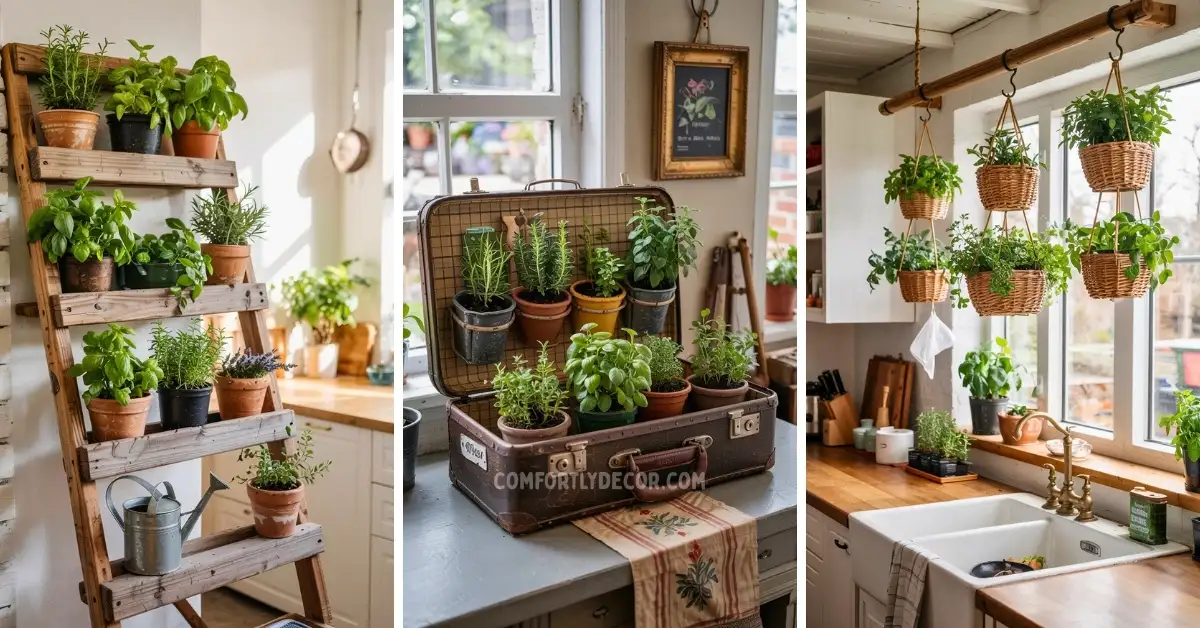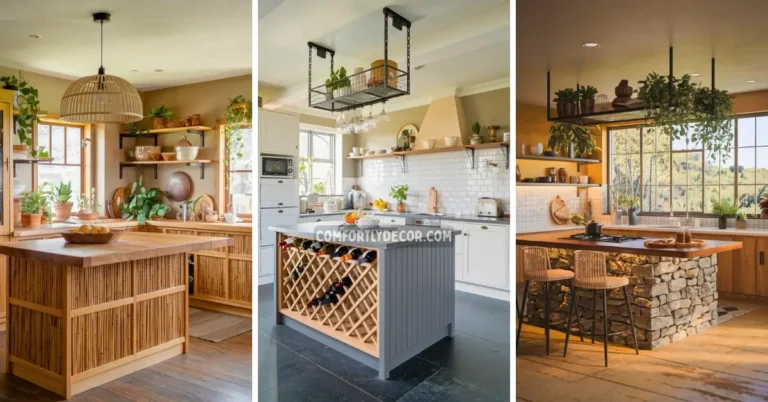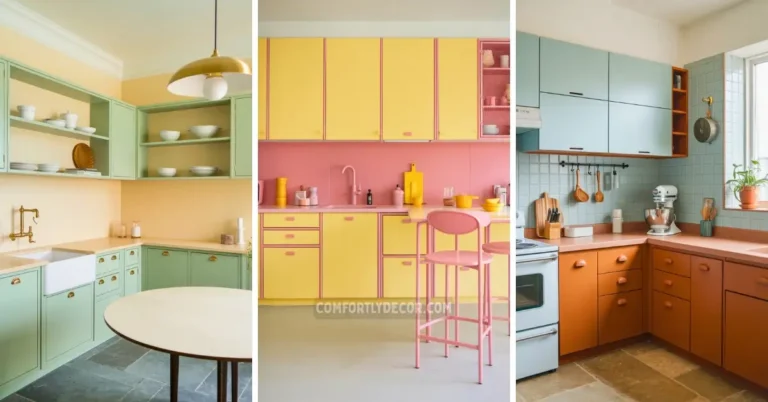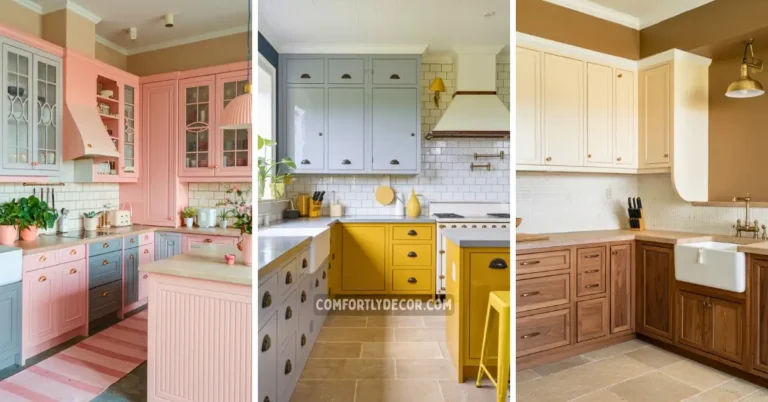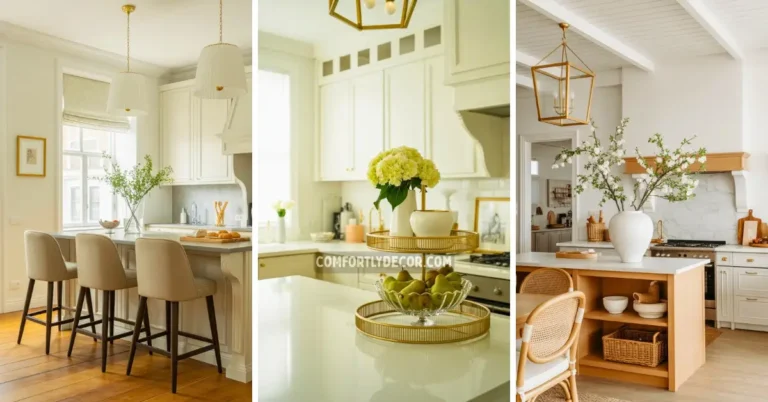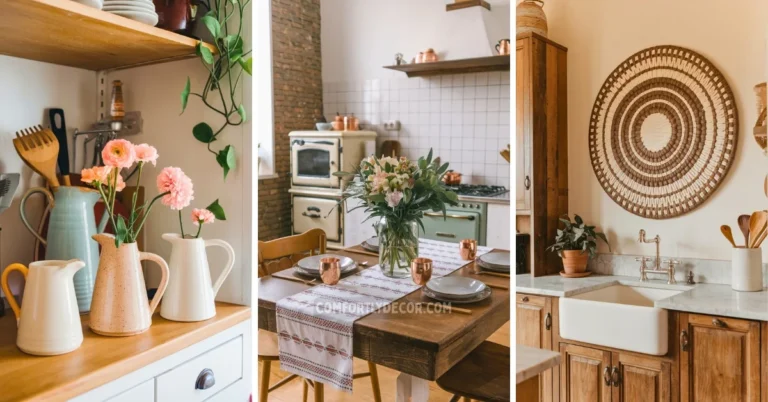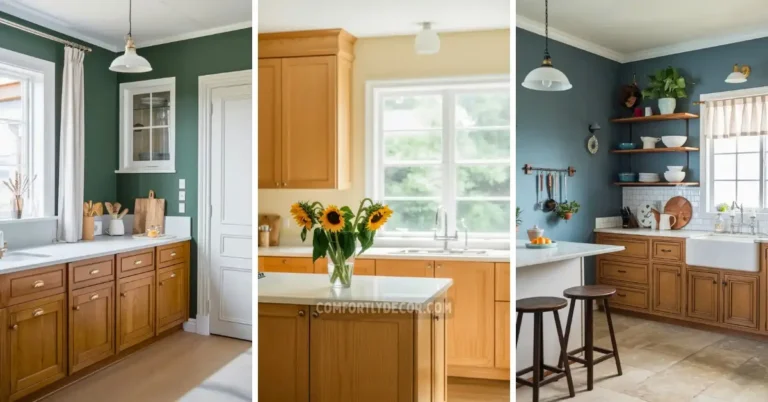15 Creative DIY Indoor Herb Garden Ideas for Kitchen Decor
Ever tried reaching for fresh basil only to find wilted store-bought leaves in your fridge? :/ Growing your own indoor herb garden solves this problem while adding serious style to your kitchen. FYI, you don’t need a green thumb or tons of space to make this work.
Indoor herb gardens are having a major moment right now, and honestly, it’s about time. Nothing beats the convenience of snipping fresh herbs while you’re cooking, plus they make your kitchen smell amazing and look way more alive.
Essential Setup Tips Before You Start
Getting your herb garden right from the start prevents headaches later. Most herbs need 6-8 hours of sunlight daily, so scope out your sunniest spots first.
Choose containers with drainage holes. This prevents root rot, which kills more indoor herbs than anything else. If you fall in love with a container without holes, drill some yourself.
Pick the right potting mix. Regular garden soil doesn’t work indoors—it’s too heavy and doesn’t drain well. Grab a quality potting mix designed for containers instead.
15 DIY Indoor Herb Garden Ideas That Actually Work
#1. Mason Jar Windowsill Garden
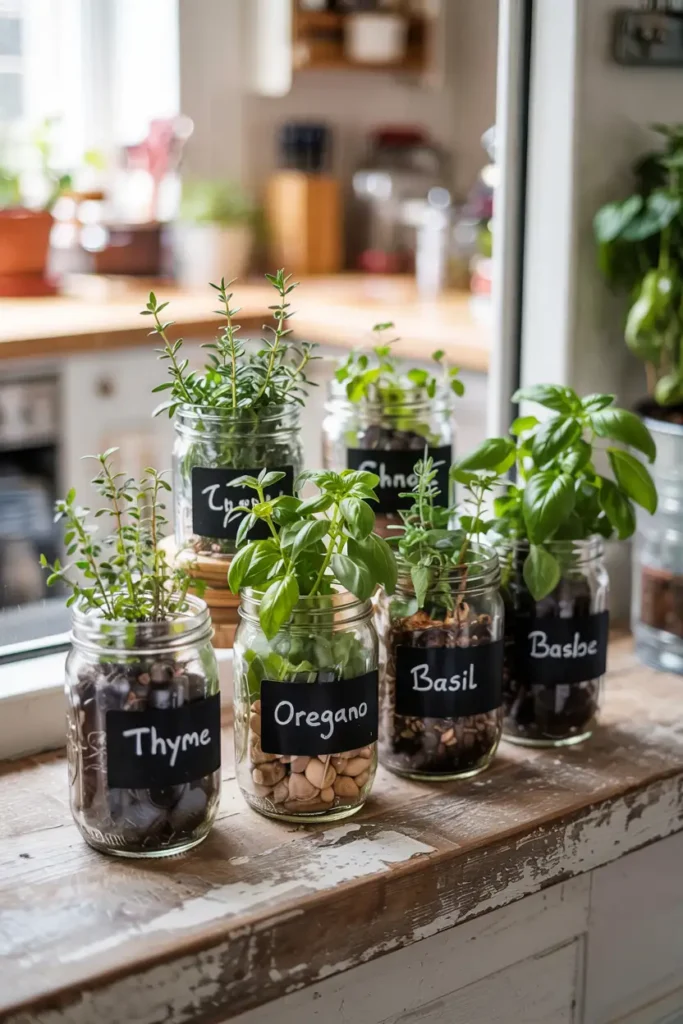
Transform ordinary mason jars into a charming herb display that screams farmhouse chic. Fill jars with small stones for drainage, add potting soil, and plant your herbs. Line them up on your sunniest windowsill.
Label each jar with chalkboard paint for that perfect rustic touch. This setup works brilliantly for compact herbs like thyme, oregano, and small basil plants.
Placement Tip: Arrange mason jars on your sunniest kitchen windowsill for maximum light exposure.
Decor Tip: Use chalkboard paint or rustic twine with handwritten labels to enhance the farmhouse charm.
#2. Vertical Pallet Herb Wall
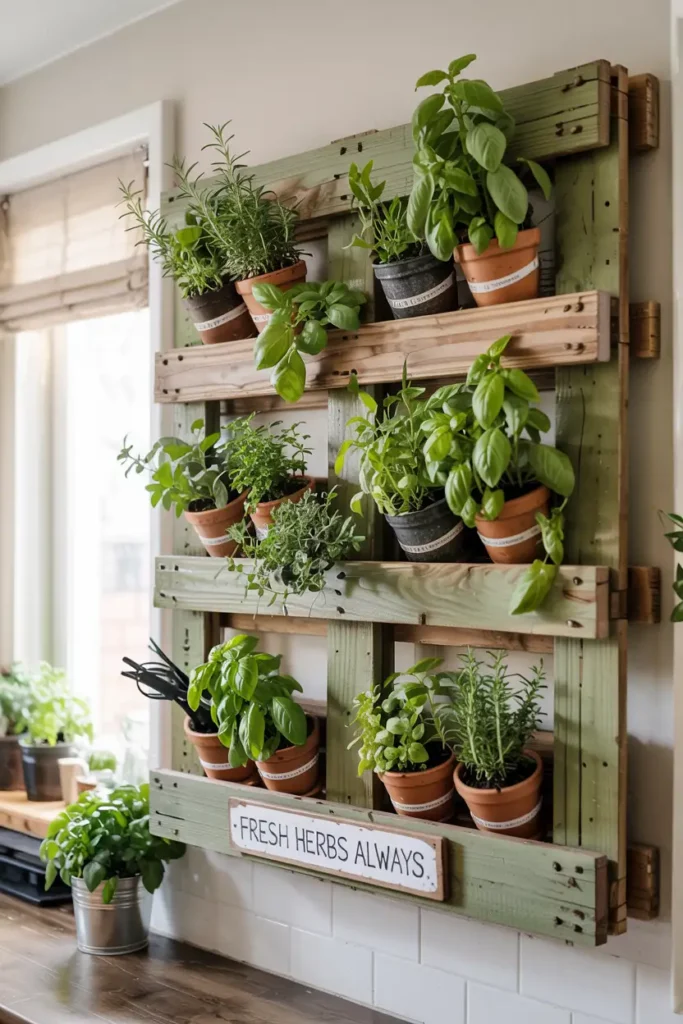
Repurpose a wooden pallet into a space-saving vertical garden that makes a serious statement. Attach small pots to the pallet slats or create planting pockets using landscape fabric.
Mount it on a wall that gets good morning light. This works perfectly for trailing herbs like oregano and creeping thyme that’ll cascade beautifully.
Placement Tip: Mount the pallet on a wall near a bright window or on a balcony door wall to maximize vertical space.
Decor Tip: Paint the pallet in a bright color or leave it natural for a rustic vibe, and use matching pots for a cohesive look.
#3. Magnetic Fridge Garden
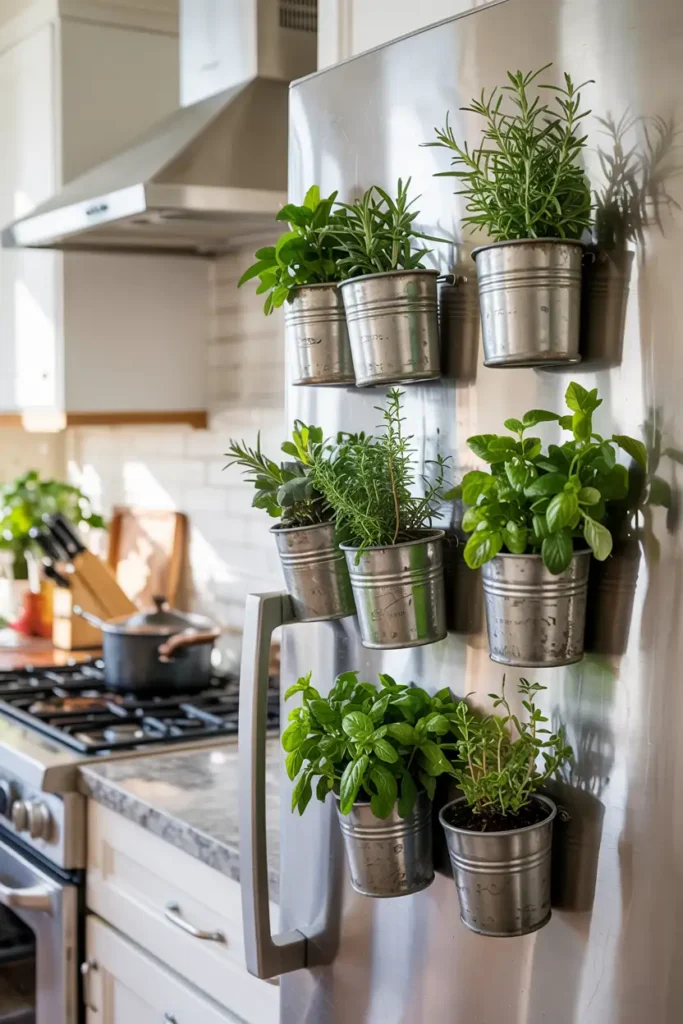
Turn your refrigerator into a growing space with magnetic containers. Use small metal containers with strong magnets attached to hold herbs like basil and parsley.
This keeps herbs at eye level and easily accessible while cooking. Plus, it looks way cooler than those usual fridge magnets collecting takeout menus.
Placement Tip: Attach magnetic containers to the side or front of the fridge, ideally near your cooking area for easy access.
Decor Tip: Choose sleek metal containers or decorate them with washi tape or vinyl stickers to match your kitchen style.
#4. Hanging Basket Display
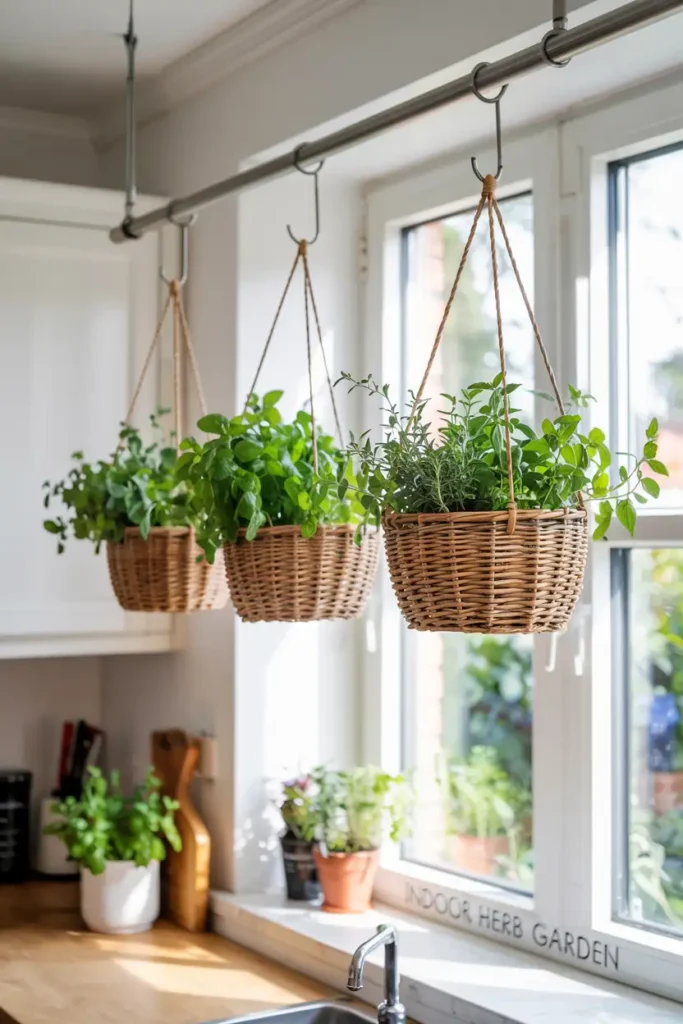
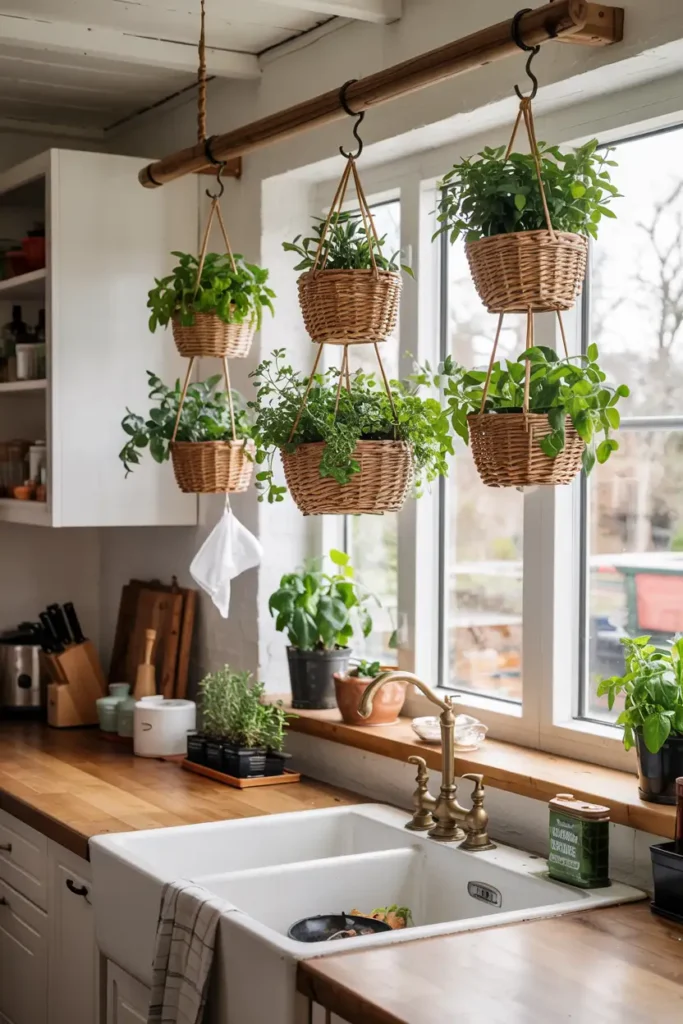
Suspend woven baskets from ceiling hooks near your kitchen window. These work especially well for herbs that like to trail, like mint and oregano.
The hanging setup keeps counter space free while creating visual interest. Choose baskets that complement your kitchen’s style—rattan for boho vibes or metal for modern looks.
Placement Tip: Hang baskets around your kitchen window or along a beam where they can get good light.
Decor Tip: Use woven baskets for a boho look or sleek metal baskets for modern kitchens, and add some colorful ribbons for extra flair.
#5. Tiered Plant Stand Corner
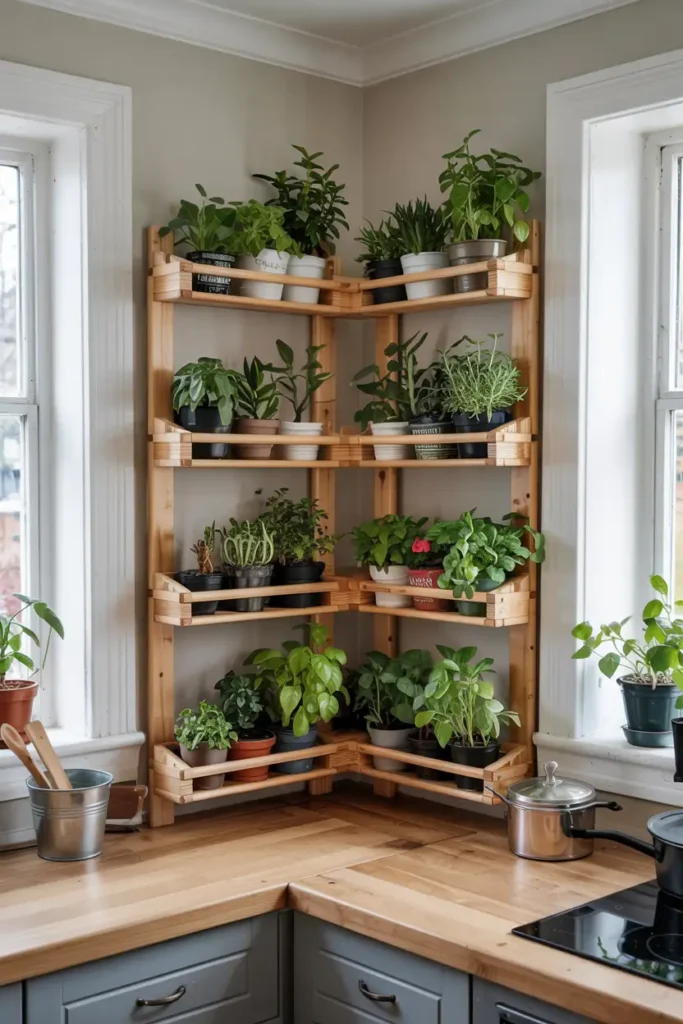
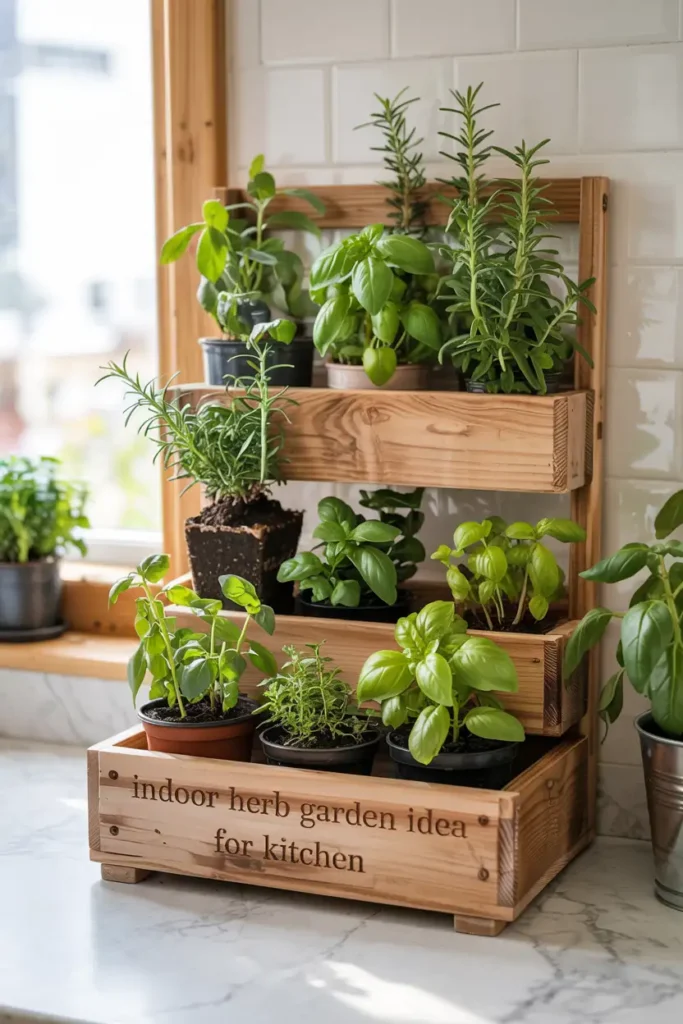
Set up a wooden plant stand in an unused corner to create an herb display with serious height variation. Arrange different sized pots on each level for a dynamic look.
This approach lets you grow more herbs in a small footprint while creating a dedicated herb zone in your kitchen.
Placement Tip: Place the plant stand in an unused corner or near a bright window to add greenery to dead space.
Decor Tip: Arrange pots in varying heights and colors that match your kitchen palette, and add fairy lights for a cozy touch.
#6. Repurposed Tin Can Garden
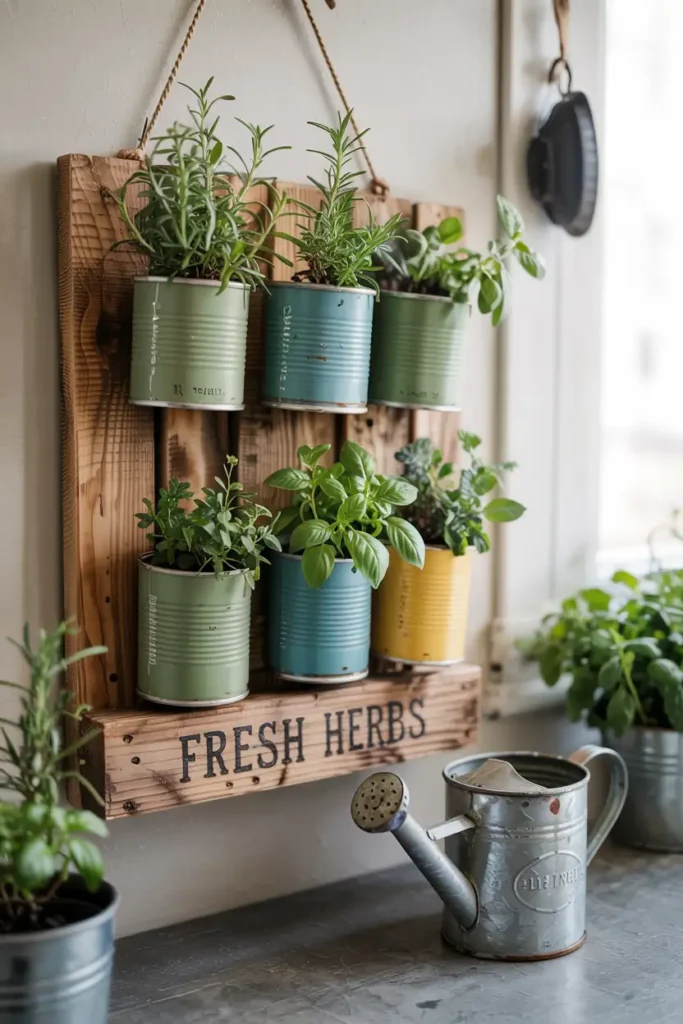
Transform empty tin cans into quirky planters with some paint and creativity. Drill drainage holes in the bottom and paint them to match your kitchen colors.
Mount them on a wooden board for a wall display or arrange them on a tray. This eco-friendly approach gives you planters for practically nothing.
Placement Tip: Set up the tin cans on a countertop, windowsill, or mount them on a wooden board as a wall display.
Decor Tip: Paint the cans in vibrant colors or metallic finishes, and add stenciled designs or patterns to make them pop.
#7. Glass Cloche Mini Greenhouse
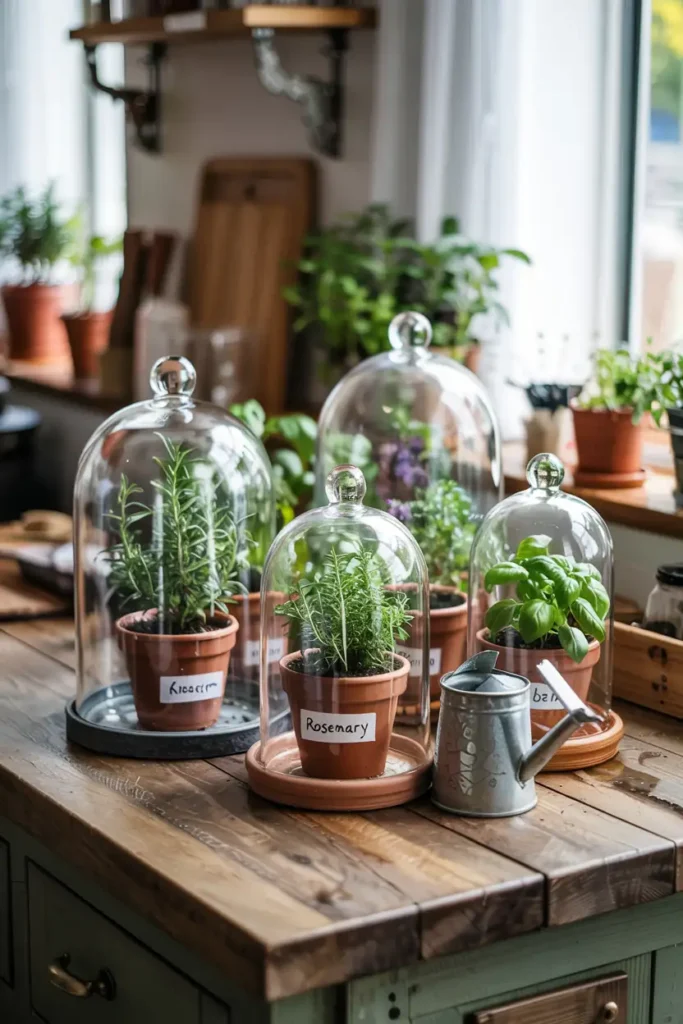
Cover individual herb pots with glass cloches to create elegant mini-greenhouses. This setup helps maintain humidity and looks incredibly sophisticated.
The glass domes protect delicate herbs while adding a French garden vibe to your kitchen. They work especially well for herbs that like consistent moisture.
Placement Tip: Place herbs under cloches on your kitchen island or a sunny counter for both functionality and decor.
Decor Tip: Use cloches with ornate designs or vintage-inspired shapes to add a touch of elegance to your setup.
#8. Rolling Cart Herb Station
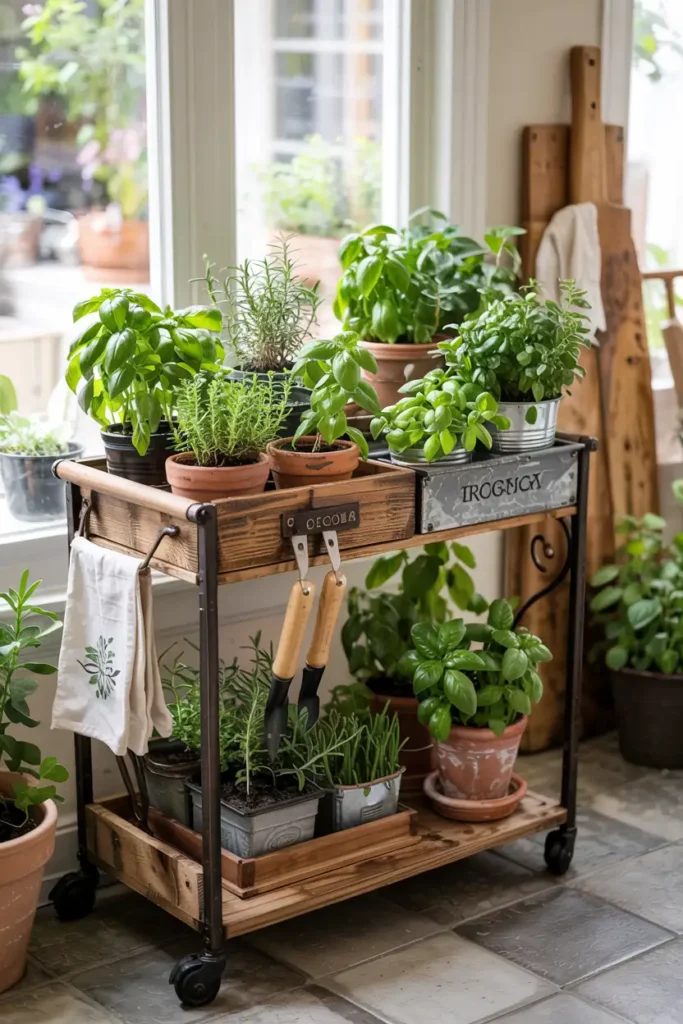
Use a kitchen cart to create a mobile herb garden that moves wherever you need it. Load it with different sized pots and arrange tools on the lower shelf.
Roll it to your prep area when cooking, then move it to the sunniest spot during the day. This flexibility makes it perfect for small kitchens.
Placement Tip: Keep the cart near a sunny spot during the day and roll it to your prep area when cooking.
Decor Tip: Add small baskets or jars for tools, and use matching pots with labels for a polished, organized look.
#9. Vintage Toolbox Planter
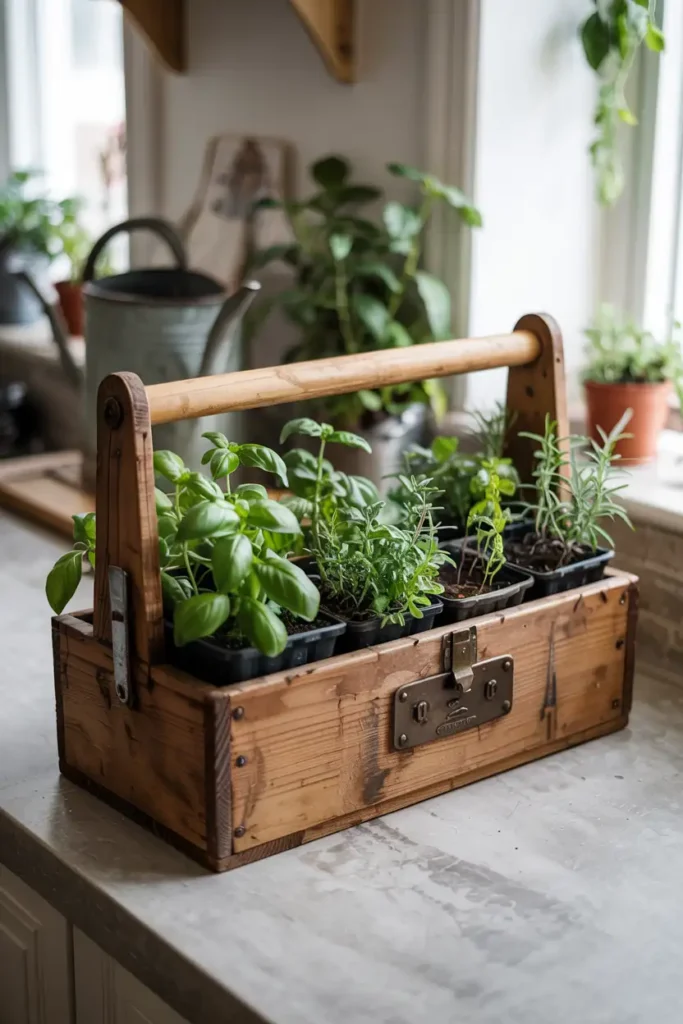
Convert an old wooden toolbox into a portable herb garden with serious character. Line it with plastic and add drainage holes before filling with soil and herbs.
The compartments naturally separate different herbs, and the handle makes it easy to move around. Hunt thrift stores for the perfect vintage toolbox.
Placement Tip: Place the toolbox on a countertop, kitchen shelf, or a small table near a window.
Decor Tip: Choose a toolbox with a weathered finish for character, and line the inside with burlap for added texture.
#10. Ladder Shelf Display
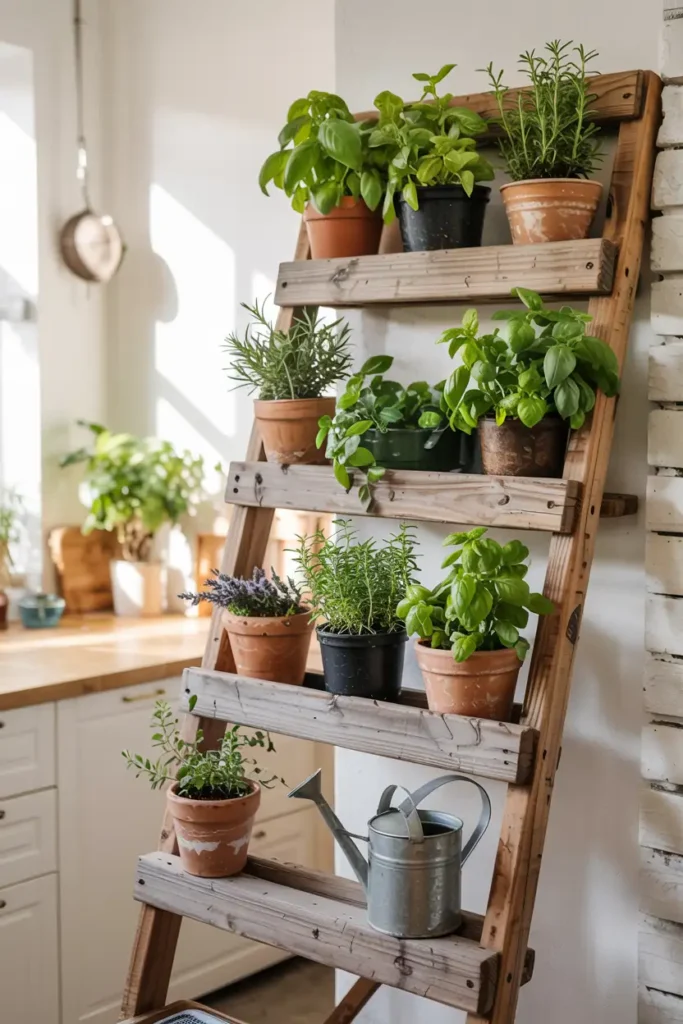
Lean an old wooden ladder against the wall and use the rungs as plant shelves. This creates instant vertical growing space with tons of rustic charm.
Arrange pots on each rung, mixing different sized containers for visual interest. The weathered wood adds texture and warmth to modern kitchens.
Placement Tip: Lean the ladder against a kitchen wall near natural light or in a corner to maximize vertical space.
Decor Tip: Use a mix of terracotta and ceramic pots for variety, and add small decorative items like candles or mini figurines.
#11. Kitchen Island Centerpiece
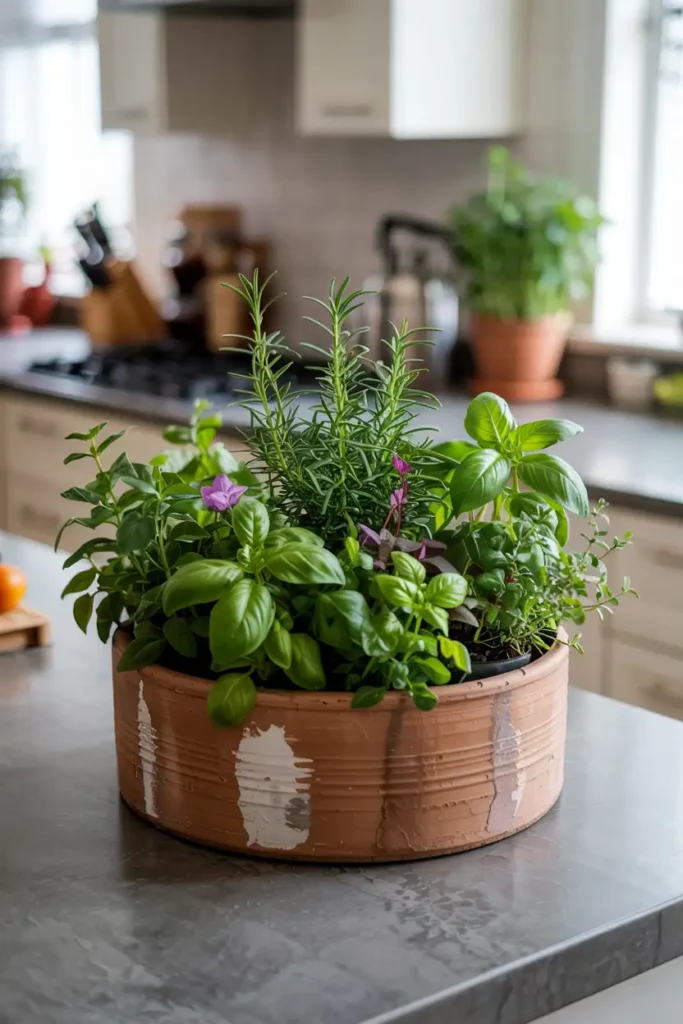
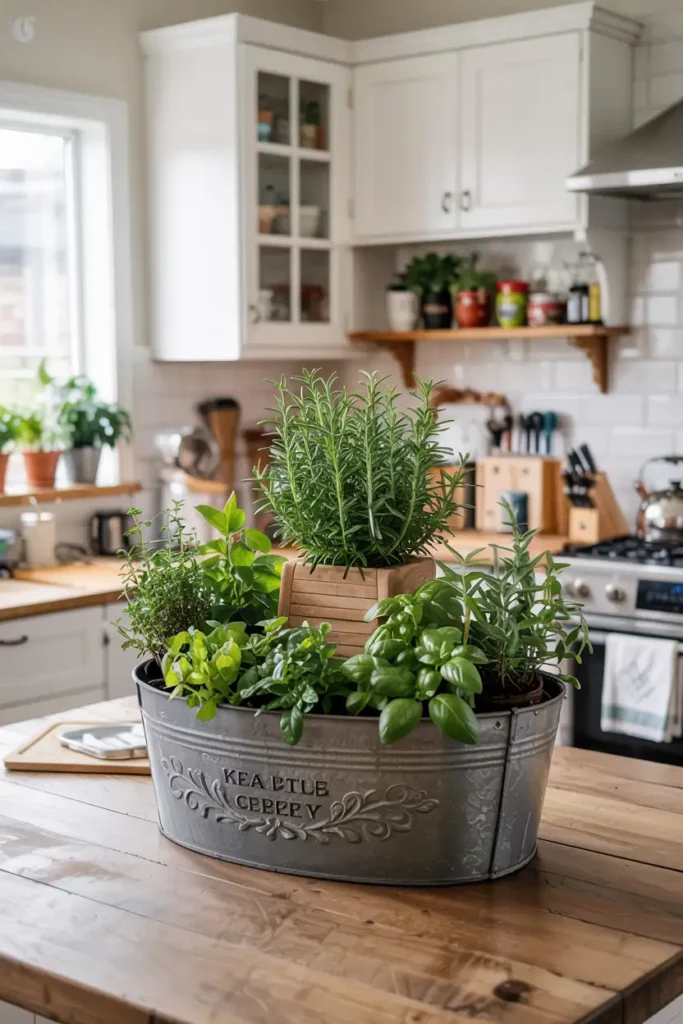
Transform your kitchen island into an herb showcase with a large, decorative planter. Choose a container that complements your island’s style and fill it with a variety of herbs.
Mix tall herbs like rosemary with trailing varieties for a full, lush look. This becomes a functional centerpiece that’s way better than fake flowers.
Placement Tip: Place the planter in the center of your kitchen island for easy access and visual appeal.
Decor Tip: Use a decorative planter that complements your kitchen theme, and combine tall and trailing herbs for a lush, layered look.
#12. Floating Shelf Herb Display
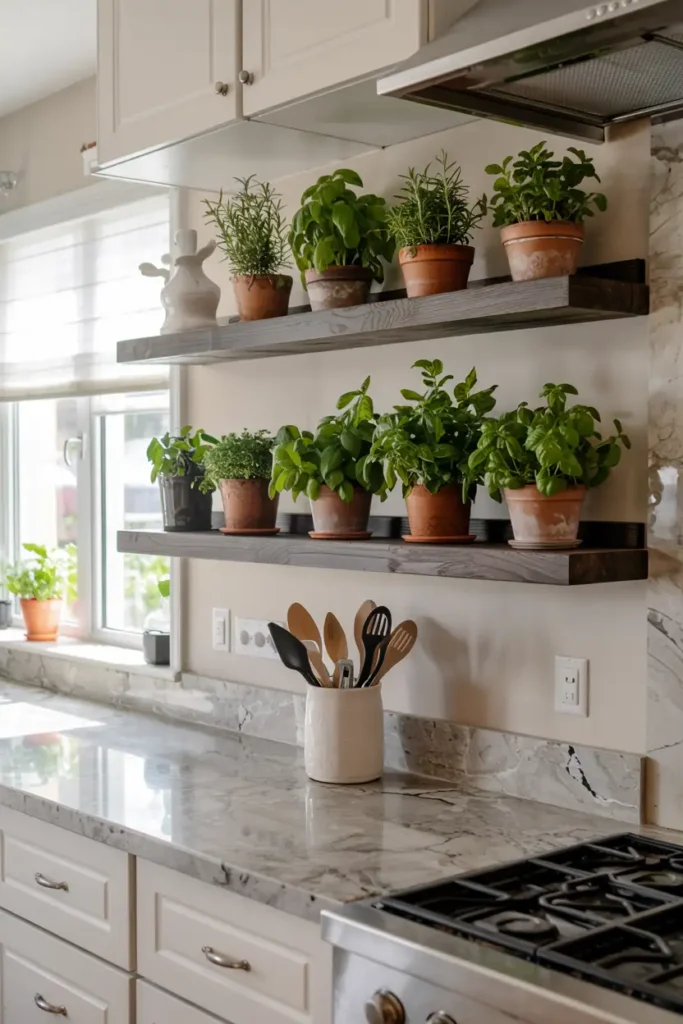
Install floating shelves specifically for your herb collection. Arrange pots in groups of odd numbers for the most pleasing visual arrangement.
This approach works great for renters who can’t make major changes. Choose shelves that match your existing kitchen hardware for a cohesive look.
Placement Tip: Install shelves above your countertop or stove area, ensuring easy access while cooking.
Decor Tip: Arrange pots in odd-numbered groups for balance, and use sleek, matching pots or jars for a minimalist look.
#13. Vintage Suitcase Garden
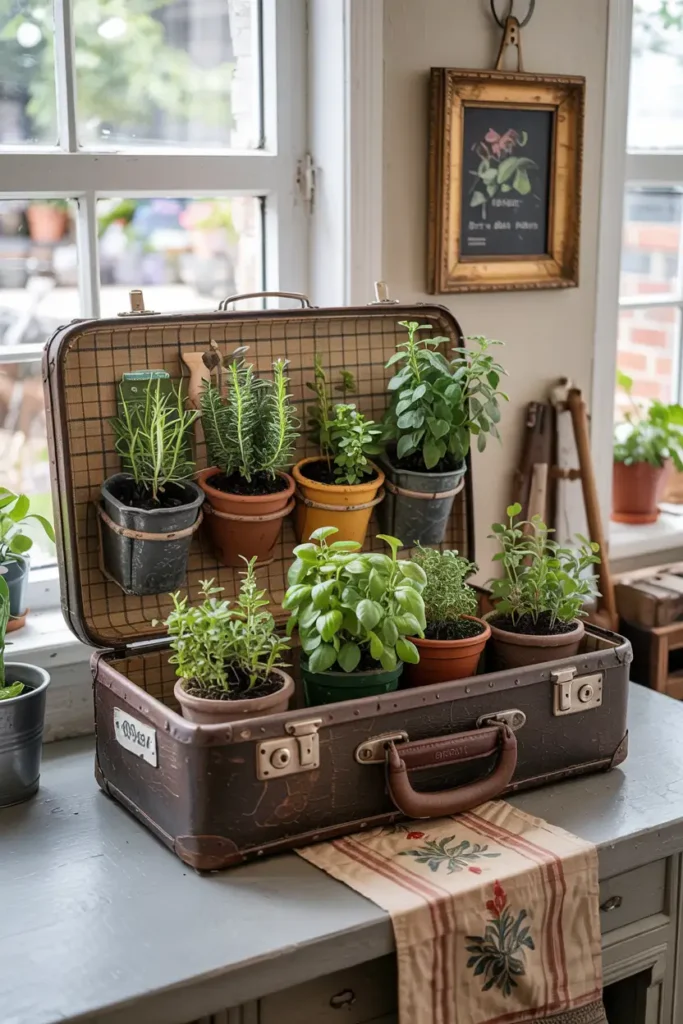
Open an old suitcase and fill it with herb pots for a whimsical garden display. The compartments naturally organize different herbs while adding serious personality.
This works beautifully as a conversation piece on a kitchen table or counter. Hunt estate sales for unique suitcases with great patina.
Placement Tip: Set the suitcase on a countertop, a table, or a small kitchen cart near a window.
Decor Tip: Choose a suitcase with vintage charm, and line it with colorful fabric or moss for a whimsical touch.
#14. Aquaponics Counter System
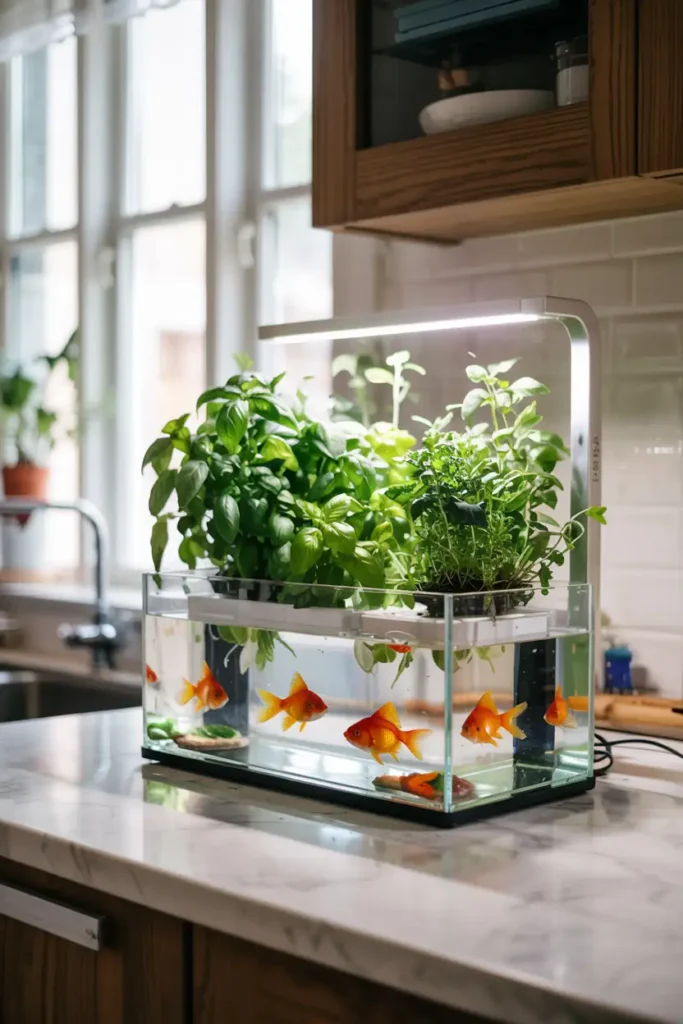
Set up a small aquaponics system that combines fish and plants in one compact unit. The fish waste fertilizes the herbs while the plants clean the water.
This cutting-edge approach fascinates guests and provides incredibly fresh herbs. It’s perfect for anyone who loves both gardening and aquariums.
Placement Tip: Place the system on a countertop near a power outlet and a natural light source.
Decor Tip: Choose an aquaponics system with a sleek, modern design and add small decorative rocks or plants to enhance its appearance.
Why Your Kitchen Needs an Indoor Herb Garden
Indoor herb gardens offer three killer benefits that’ll make you wonder why you waited so long to start one.
Fresh herbs taste better than anything you’ll buy at the store. Those plastic containers of herbs lose flavor fast, but when you grow your own, you get maximum taste every single time.
They save you serious money. A single packet of store-bought basil costs what you’d spend on seeds that’ll give you herbs for months.
Your kitchen gets an instant style upgrade. Green plants make any space feel more welcoming and put-together.
How to Care for Your Indoor Herb Garden
Watering Tips
Proper watering is essential to maintaining a healthy indoor herb garden. Most herbs prefer slightly moist soil, but overwatering can lead to root rot. Check the soil regularly—water when the top inch feels dry, and always ensure pots have proper drainage.
Sunlight Requirements
Herbs thrive in bright, indirect sunlight. Position your garden near a south-facing window for optimal light, or consider using grow lights during darker months to ensure your herbs receive at least 6-8 hours of light daily.
Pruning and Harvesting
Regular pruning encourages growth and helps maintain the shape of your herbs. Snip leaves or stems just above a growth node only when the plant has matured enough to replenish itself. Use fresh-cut herbs immediately to enjoy their fullest flavor.
Choosing the Right Herbs for Your Kitchen
Easy-to-Grow Herbs
Basil, mint, parsley, and chives are among the easiest herbs to grow indoors, making them ideal for beginners. They require minimal care and adapt well to most kitchen environments.
Herbs for Specific Uses
- Cooking: Thyme, oregano, and cilantro pair beautifully with a variety of dishes.
- Tea-Making: Mint and chamomile are perfect for calming herbal teas.
- Aromatics: Lavender adds a subtle fragrance to your indoor space.
Container Selection
Invest in containers that offer both functionality and aesthetic appeal. Look for pots with drainage holes to prevent waterlogging while suiting the style of your kitchen or home. Hanging planters, wooden boxes, or ceramic pots can all add character to your setup.
Adding Style to Your Herb Garden Setup
Personalize with Labels
Create custom plant labels for your herbs using chalkboard sticks, painted stones, or wooden tags. This adds a personal touch while helping you identify your plants at a glance.
Decorate the Planters
Enhance the visual appeal by decorating planters with paint, patterns, or even repurposed household containers like mason jars. Choose materials and styles that match your kitchen decor.
Incorporate Lighting
If natural lighting is limited, add stylish grow lights to keep plants thriving. Pendant or under-cabinet grow lights can be both functional and visually pleasing.
FAQs
Transform Your Kitchen Into a Green Paradise
Indoor herb gardens aren’t just about having fresh ingredients—they’re about creating a kitchen that feels alive and inspiring. Whether you choose mason jars or a full aquaponics setup, you’re investing in better cooking and better living.
Start small with a few easy herbs, then expand as you gain confidence. Your future self will thank you every time you reach for fresh basil instead of that sad, expensive plastic container.
Ready to get growing? Pick one idea that speaks to you and get started this weekend. Your kitchen transformation begins with a single herb!

I am Mindy Medford, a home décor, paint, and design specialist with over a decade of hands-on experience transforming ordinary spaces into cozy, personality-packed havens. Since 2013, I have been helping homeowners discover the art of beautiful yet practical design. I share my love for color, texture, and layout—making stylish interiors & exteriors feel achievable for everyone. Whether it’s picking the perfect paint shade or reimagining a small space, I’m here to guide and inspire.

